Abstract
Under carbon peaking and neutrality constraints, low-carbon retrofitting of residential buildings (LRRB) has become a strategic need for most countries worldwide. However, the development of China’s LRRB market still relies on government guidance without moving towards the goal of autonomous orientation. This area is still a concern for academics. Moreover, many stakeholders are involved in the LRRB, and the secondary stakeholders’ behavioral strategies do not substantially impact the LRRB. So, this paper adopts Mitchell’s score-based approach to identify the core stakeholders, followed by a tripartite evolutionary game model of government, ESCOs, and owners. Based on the system dynamics (SD) model, the evolution rules of the three parties’ behavior strategies and evolution stabilization strategies are analyzed, and the key factors influencing the equilibrium are found. The results of the study show that under the condition that the government adopts the same level of subsidy for ESCOs and owners, ESCOs are more sensitive to the subsidy; with the introduction of penalties under the premise of subsidy, ESCOs can reach evolutionary equilibrium faster; and when the benefits of owners accepting LRRB outweigh the losses, owners will eventually choose to accept retrofit regardless of whether the government subsidizes owners or not. Finally, the paper ends with suggestions for developing an LRRB market. The game model proposed in this paper can provide a scientific reference for stakeholders’ carbon reduction decisions.
1. Introduction
Global warming threatens sustainable socio-economic development and has become the greatest challenge to the progress of human society. In order to break out of this dilemma, all governments are committed to formulating efficient macro policies and introducing various measures to reduce greenhouse gas emissions. Among them, the Chinese government also announced at the 75th session of the United Nations General Assembly that it will reach the goal of carbon peaking by 2030 and carbon neutrality by 2060 [1]. Low carbon, green technology, and recycling will be the future direction of environmental development [1]. The construction industry is one of the most severe industries in the world in terms of energy consumption and environmental pollution, accounting for 30% of global greenhouse gas emissions [2]. This phenomenon is even more severe in China, especially in residential buildings. According to the China Building Energy Consumption Research Report (2020) [3], in 2018, China’s total area of residential buildings (urban and rural residential buildings) was 54.3 billion m2, accounting for 81% of the total building area. Their energy consumption was about 1 billion tons of standard coal per year, accounting for about 76% of the overall energy consumption of the construction industry. In addition, the carbon emissions of urban and rural residential buildings account for 42% and 37% of the total, respectively. Due to the enormous stock of high-energy residential buildings, even though the state is now vigorously promoting low-carbon buildings, it still cannot compensate for the negative impact of the existing high-energy buildings. Therefore, LRRB is a crucial way to achieve sustainable urban development and has far-reaching significance for the environmental-friendly development of the construction industry and the achievement of the “double carbon goal”.
As a system project, LRRB results from multiple stakeholders’ joint participation and interaction. However, the significant heterogeneity of each subject has led to the hindrance of industrial development. Many stakeholders are involved in the LRRB, and the behavioral strategies of secondary stakeholders have little impact on the low-carbon retrofit of buildings; therefore, this study identifies the core stakeholders as the government, ESCOs, and owners. The three core stakeholders were analyzed. From the supply side, ESCOs have high short-term costs for low-carbon retrofitting of buildings, high challenges for technological innovation, and insufficient motivation for the low-carbon transformation of enterprises. From the demand side, homeowners have weak low-carbon awareness and low willingness to consume, blind spots for energy-saving information, and high transaction costs for searching, bargaining, monitoring, and implementing energy-saving services, resulting in sluggish endogenous motivation for homeowners. From the regulation perspective, the government has vigorously promoted the development of the LRRB market, formulated a series of policy measures, such as subsidies, tax reduction, and carbon emissions trading, and formed a regulatory model combining mandatory, market-based, and voluntary [4]. However, the corresponding policy measures are not yet sound, and it is not easy to fully play the role of guidance [5]. Due to the different goals and interests of core stakeholders, information asymmetry, and limited rationality, the long-term development of LRRB depends on the behavioral strategies of core stakeholders. In order to promote LRRB, it is necessary to study the behavioral strategies of core stakeholders under different situations. Unfortunately, there are still relatively few studies on the behavioral strategies of core stakeholders in LRRB. Specifically, there needs to be more theoretical perspectives to analyze the impact of stakeholders’ behavioral decisions on the LRRB market under different scenarios.
In order to address the above questions, this paper analyzes the behavioral strategies and interaction mechanisms of the government, ESCOs, and owners in different situations based on the tripartite evolutionary game theory. In other words, this study answers the following questions:
- (1)
- How to identify the core stakeholders?
- (2)
- What are the stable equilibrium states and corresponding conditions for LRRB?
- (3)
- How do the strategic behaviors of stakeholders and related factors affect the evolution of the equilibrium state?
To achieve the above objectives, this study works along the following lines:
- (1)
- Adopting Mitchell’s score-based approach to identify the core stakeholders from many stakeholders as the main body of the LRRB.
- (2)
- Using the evolutionary game approach to construct a tripartite evolutionary game model of government-ESCOs-owners to explore the evolution of the behavioral strategies of the three core stakeholders in the LRRB.
- (3)
- Using Vensim PLE 7.3.5 software to simulate to explore the interaction mechanism of the three parties of the game and the influence of different parameters on the behavioral strategies of the three parties and provide a theoretical basis and valuable reference for the development of the LRRB market in China.
2. Literature Review
In order to understand the application of evolutionary game theory in building retrofitting, this study used the VOSviewer tool and selected several keywords to search for papers in this field. The site searched was Web of Science. The keywords searched were (Tripartite* evolutionary game OR Evolutionary game theory) AND (Building energy saving reconstruction OR Building retrofit* OR Building renovation* OR Architectural renovation OR Residence Refurbishment). Since there are few studies on the evolutionary game of LRRB, we added “green building” to the keyword search to increase the number of results for the relevant literature. Through screening, 46 papers were obtained. Figure 1a shows that the most recent topics are incentives and energy efficiency, which indicates that government incentives and policies have received much attention in recent years. From Figure 1b, the keywords “evolutionary game”, “green building”, and “policies” have a high keyword density, which indicates that these three keywords frequently appear in related studies. Therefore, this study discusses the literature from three aspects: “government incentives”, “evolutionary game in the building market”, and “stakeholders”, taking into account the theme of this study. The study will discuss the literature from three perspectives: “government incentives”, “evolutionary game of building renovation market”, and “stakeholders”.
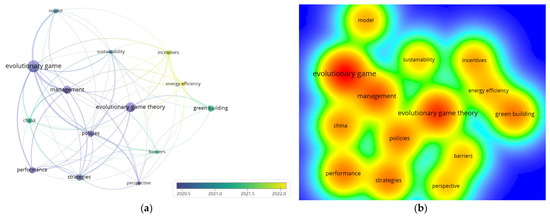
Figure 1.
The keyword clusters. (a) Cluster network of keywords; (b) Density visualization of keywords.
2.1. Government Incentives
In terms of incentive mechanisms, Khashe et al. [6] pointed out through virtual simulation experiments that financial subsidies can effectively promote the evolution of owners’ behavioral strategies in a positive direction. Liu et al. [7] studied the dynamic evolutionary game between the government and consumers based on passive building demand incentives. It clarified that the focus of efforts to stimulate passive building demand is the government, and the initial willingness of the government and consumers will directly affect the behavioral strategies of both parties. Wang et al. [8] constructed an evolutionary game model for construction waste recycling projects involving the government and social capital. It found that the government’s implementation of a dynamic reward–punishment mechanism has a better incentive effect than a static one. Janez Dolšak et al. [9] evaluated the impact of a subsidy program for energy retrofit in household buildings introduced in Slovenia in 2009. The results show that the determinants affecting the implementation of energy efficiency retrofits were the household’s financial situation, past retrofitting activities, the home’s location, age and type of the building, and electricity expenditures. Feng et al. [10] developed an evolutionary game model in which government subsidies were used to analyze the evolutionary equilibrium strategies of builders and buyers under different scenarios. The results show that the government subsidy has a positive effect on green building development but only has a small positive impact on the buyer.
2.2. Evolutionary Game Analysis on the Building Renovation Market
Most researchers mainly focused on retrofitting existing building technologies or solutions [11,12]. Later, researchers gradually realized that stakeholders’ willingness to retrofit has a certain degree of influence on the building’s retrofit market, so the evolutionary game was conducted on the stakeholders of the building retrofit market. However, the research subjects are mostly limited to two-party evolutionary games, which mainly revolve around the government and developers. Yang et al. [13] studied the green retrofit of public–private partnerships to redevelop buildings and explained the changes in the game strategies of the government and investment enterprises through game evolutionary theory analysis. The outcome of the evolution game will be as follows: Firstly, the government will encourage the green transformation and the investment enterprises to carry out the green transformation. Secondly, the government does not encourage green transformation, and investment enterprises do not carry out green conversion. The third is that the government does not encourage green transformation, and investing enterprises need to implement green transformation. The results show that when the government encourages green retrofitting, the willingness of investment enterprises to implement green retrofitting increases. Furthermore, combining positive and negative policy incentives will be a better and more sensible way to promote the public–private partnership to redevelop buildings for green retrofitting. Zhang et al. [14] explored the evolutionary game of government monitoring and contractors’ green construction behavior strategies under the role of self-media. They analyzed the effects of positive publicity and harmful exposure to self-media on the strategic choices of government and contractors in the game. Research shows that positive publicity and harmful exposure strategies significantly promote the system’s convergence toward an ideal stability strategy. Even though the government punishes contractors excessively because of non-green behavior, it can still reach an ideal stable strategy through reasonably adjusting propaganda willingness and exposure ability.
With further development of the research, the subjects of the evolutionary game are gradually transformed from two to three parties, and scholars have considered the factors that affect the evolutionary game model of the construction market more comprehensively. Qiao et al. [15] used a three-star residential building in Tianjin as an example to construct an evolutionary game model between “government-developer-consumer” to reveal the interaction mechanism among the stakeholders and identify the key factors affecting the evolutionary equilibrium of the system. The results show that government guidance influences the speed and results of system evolution, while the cost and benefit determine the stakeholders’ strategy. Liu et al. [16] introduced public monitoring and a penalty mechanism to analyze stakeholders’ motivation and decision behavior in the green building supply market. They built a tripartite evolutionary game model of government, supplier, and developer. The study found that adverse public regulation may affect government regulation. Excessive subsidies and penalties may prompt some players to opt for non-green behavior. Qiao et al. [17] constructed a tripartite evolutionary game model of local government, owners, and ESCOs. They used the replicated dynamic approach of evolutionary game theory to explore the evolutionary process of three-party stabilization strategies during the development of market cooperation. The study shows that the government’s guidance strength, excess cooperation revenue, revenue distribution coefficient, and non-cooperation liquidated damages are the key factors influencing the cooperation behavior of the subjects. Then it proposes countermeasures to promote the development of the building energy retrofit market in four aspects: building a credit system, implementing guidance mechanisms, optimizing revenue distribution, and promoting technological innovation. Huang et al. [18] constructed an evolutionary game model for rural residential energy efficiency retrofitting based on government, ESCOs, and rural residents. On this basis, they analyzed the factors influencing their behavior. It is found that changes in stakeholders’ initial willingness ratio, government subsidies, or fines do not change their behavioral strategy choices when their benefits exceed their costs. Three main factors affect the parties’ cooperation: government subsidies and fines, society’s overall benefits, and government regulation costs.
Based on the current research, most studies directly selected the three subjects in the evolutionary game. In the actual situation, the LRRB market involves many stakeholders, such as ESCOs, governments, owners, financial institutions, third-party certification bodies, social groups, and energy supply units. Some of these stakeholders do not play a substantial role in the LRRB. Therefore, screening out the core stakeholders can help the researcher to identify the key factors affecting the LRRB faster and reduce the amount of work for the researcher in the research process.
2.3. Stakeholders Screening
The low-carbon retrofit involves many relevant stakeholders. Regarding identifying core stakeholders, most scholars summarized the subjects involved in the project by reviewing the literature. After constructing the adjacency matrix using the expert scoring or snowball method, they used social network analysis to identify the core stakeholders. Xu et al. [19] identified the stakeholders in the coastal city affordable housing project. They established a social relationship matrix of stakeholders by using a questionnaire survey method and social network analysis. Then, based on the social relation matrix, network centrality, and cohesion, subgroup analyses are used to identify key stakeholders in coastal city affordable housing projects. Liang et al. [20] proposed a new Social Network Analysis model, which introduced critical success factors as an intermediate variable between the stakeholders and the success of the project. The model shows the interaction of stakeholders and essential aspects of success and reveals stakeholders’ impact on the project’s success. Xue et al. [21] established a network-based framework based on stakeholder theory. After stakeholder identification using social network analysis, a stakeholder-conflict map is proposed by detecting and analyzing the relationship between crucial conflicts and stakeholders. Management strategies are offered based on this.
3. Methods
This paper innovatively adopts Mitchell’s score-based approach to identify the core stakeholders, followed by a tripartite evolutionary game model of government, ESCOs, and owners. In identifying and classifying stakeholders, Mitchell’s score-based approach has excellent operability [22]. This approach consists of three properties: (1) Power: whether or not an organization has the position, capability, and appropriate means to influence decision-making. (2) Legitimacy: whether the group has legal, moral, or specific rights to claim the project. (3) Urgency: the ability of an application made by a group to be immediately addressed. Stakeholders were scored based on these three attributes, and the researcher classified stakeholders into three categories based on their scores: core stakeholders, dormant stakeholders, and marginal stakeholders.
The heterogeneity of needs and the complexity of interest relationships among stakeholders determine the necessity of studying the behavior of core stakeholders in building retrofit [2]. In practice, there may be potential cooperation among stakeholders, and another party may influence their individual decisions. During this process, the subjects observe, imitate, learn from other people, and constantly adjust to get more benefits for themselves [23]. This dynamic process can be explained by evolutionary game theory, which shows the dynamic evolution process and the equilibrium status of all stakeholders’ strategies in bounded rationality.
3.1. Core Stakeholder Identification
There are many stakeholders involved in the LRRB. This paper summarizes the stakeholders in building retrofits by reviewing the relevant literature [20,24,25,26,27,28]: ESCOs, owners, financial institutions, government, energy supply units, property management companies, third-party certification bodies, and social groups. However, some stakeholders have a minuscule role in implementing the project. Therefore, this paper invited five experts to score the three characteristics of Power, Legitimacy, and Urgency of stakeholders involved in the LRRB using the Mitchell score-based approach [29,30]. The score is between 0 and 10 (0: weakest characteristic, 10: most vital characteristic). Secondly, the stakeholders involved in the project are identified and classified. Finally, the core stakeholders are identified, and the core stakeholders are taken as the subjects of the evolutionary game. The results of expert scoring are shown in Table 1.

Table 1.
Basic information on measured buildings.
The results may be inaccurate if the study determines the type of stakeholders based only on the means ranking. Therefore, this paper combines the use of the “paired samples t-test” in IBM SPSS Statistics 25 to determine whether the difference between the mean of the two variables above is significantly different from zero to determine the type of stakeholders. In the table below, data not enclosed in parentheses indicate the difference between the mean of a stakeholder’s rating on that dimension and the mean of another stakeholder’s rating on that dimension. If this difference in means passes the 95% or 99% confidence test, it is marked with an * or **. If it does not pass the test, an underline is placed under the data of the difference of means. Data in parentheses are t-test values; the statistical results are shown in Table 2, Table 3 and Table 4.

Table 2.
Results of paired-sample t-test for stakeholder power.

Table 3.
Results of paired-sample t-test for stakeholder legitimacy.

Table 4.
Results of paired-sample t-test for stakeholder urgency.
From the analysis of Table 2, Table 3 and Table 4, it is concluded that the government, ESCOs, and owners do not have statistical differences in the three dimensions of Power, Legitimacy, and Urgency. In other words, the three stakeholder experts, government, ESCO, and the owner, have similar ratings and are initially classified as the same type. Similarly, financial institutions, energy supply units, and third-party certification bodies are originally grouped into one category. Property management companies, research institutions, and media were initially grouped into another category.
The range of the mean scores of the stakeholders in the three dimensions of the building low-carbon retrofit is [4, 10), and the segment is divided as follows: (1) Those who score in the range of [8, 10) for at least two dimensions are core stakeholders. (2) Stakeholders with at least two dimensions scoring in the range of [6, 8) are dormant stakeholders. (3) Marginal stakeholders with at least two dimensions in the range of [4, 6). Stakeholders were classified according to the above classification requirements and combined with the results of the paired-sample t-test to derive the classification of these nine stakeholders in the three dimensions. The classification results are shown in Table 5.

Table 5.
Statistics on the classification results of building low carbon retrofit stakeholders in three dimensions.
Table 5 shows that the core stakeholders are government, ESCOs, and the owners. Therefore, this study selects the government, ESCOs, and owners as the subjects of the tripartite evolutionary game.
3.2. Tripartite Evolutionary Game Model Assumptions and Establishment
3.2.1. Analysis of Subjects’ Behavior
The government assumes the dual role of incentive and regulation in LRRB. As a policy maker and for motivation, the government provides incentive policies such as building planning, land transfer, infrastructure support construction, and tax incentives to mobilize each participating subject to carry out LRRB. As the regulator and coordinator of the LRRB market, the government adopts tax penalties for subjects who do not meet the standards of the LRRB market and governs market failures [18]. The clear guidance of the government leads to enhanced government credibility and social benefits, which generates more potential benefits for the government [31].
ESCOs play a central driving role in LRRB, which use contract energy management to sign energy efficiency service contracts with customers and ensure that the energy savings and energy efficiency benefits specified in the contracts are achieved. Its revenue is paid by the energy efficiency benefits of completing the project [32]–in other words, to obtain the maximum benefit with the least cost. In the early stage of LRRB, ESCOs need to invest in many new techniques and materials. The high cost and long payback period of LRRB makes it so the benefits of ESCOs do not offset the expensive initial costs. This situation can cause ESCOs to use asymmetric market information to cheat owners and gain excess revenue by providing unqualified services.
Owners are the demanders of LRRB and provide the endogenous impetus for market development. The purpose of owners accepting LRRB is to save energy use and increase the lifetime of the building, thus obtaining a better quality of life at a lower cost of living. Among them, the owner’s living experience and satisfaction play a decisive role in the low-carbon development and promotion of the building [33]. The market price, health performance, and supporting facilities of LRRB are the basis for owners to choose whether to carry it out [34]. In addition, owners generally focus on the short-term benefits of the project, and it is challenging to explore the overall benefits of LRRB in the life cycle with a long-term perspective. The long payback period and uncertainty of investment returns of LRRB lead to the weakened demand of owners for energy saving and narrow market space. At the same time, information asymmetry gives owners a blind spot for energy-saving information. They are skeptical of ESCOs’ credit, technical level, and service level, which also leads to the endogenous motivation of owners to carry out a retrofit [35]. Therefore, only when owners recognize the value of LRRB and are willing to pay certain incremental costs for it can the value of LRRB be truly reflected.
3.2.2. Basic Assumptions of the Model
- (1)
- Game subjects
The game involves three participating groups: the government, ESCOs, and owners. All of them have bounded rationality in the tripartite evolutionary game analysis.
- (2)
- Strategic behavior of game players
In the process of LRRB, two different strategies are available for each subject. The government’s behavior strategy set = {GR, NGR}. “GR” means that to promote the market’s stable development, the government subsidizes owners and ESCOs who support LRRB and imposes fines on ESCOs who engage in speculative behavior. “NGR” means that the government chooses not to take any measures of the high cost of regulation and the difficulty of market supervision.
ESCO’s behavior strategy set = {QS, NQS}. “QS” refers to the strict implementation of relevant standards by ESCOs to improve their market competitiveness and long-term development. “NQS” refers to the speculative behavior of ESCOs in pursuit of short-term benefits and excessive returns.
Owner’s behavior strategy set = {AR, NAR}. “AR” refers to owners accepting LRRB to improve the quality of living buildings, improve the living environment, and obtain government subsidies. “NAR” means that the owners do not know enough about the LRRB and choose not to accept the retrofit because they are worried that the service provided by the ESCOs is unqualified.
- (3)
- Probability of behavioral strategies
Assume that the probability of choosing a behavioral strategy among subjects is in the range of [0, 1]. For ESCOs, “QS” probability is ; “NQS” is . For the government, “GR” probability is ; “NGR” is . For owners, “AR” probability is , and “NAR” is .
- (4)
- Parameter assumptions and their implications
An analysis from the government’s point of view: when the government does not implement regulation and control, the owners accept LRRB and ESCOs provide qualified low-carbon services, and the government obtains the essential benefits ; when the government adopts regulation and control measures, the service quality of ESCOs is improved, and the owners are more motivated to carry out LRRB, which in turn leads to the development of the LRRB, at which time the government can obtain the incremental benefits due to the retrofit. In the meantime, when the government decides to regulate, it also makes related laws and regulations. It consumes a lot of human resources, material, and financial resources in guidance and propaganda, thus generating control costs . Meanwhile, the government gives subsidies of and to owners who receive LRRB and ESCOs who provide qualified low-carbon services and tax penalties to ESCOs who provide unqualified low-carbon services. However, when the ESCOs provide unqualified low-carbon services, the government will pay the market governance costs to ensure the orderly development of the market.
An analysis from the ESCOs perspective: when the owners accept the LRRB and the ESCOs provides unqualified low-carbon services, at this point, the ESCOs have an initial gain of . The ESCOs provide unqualified low-carbon services with potential losses , such as reduced market share and loss of partners. If the owners accept the LRRB and the ESCOs provide qualified low-carbon services, it incurs an incremental cost . However, it gains incremental benefits , such as reputation enhancement and market share increase.
From the owners’ perspective, when the owner accepts the LRRB and the ESCOs provide qualified low-carbon services, the owners’ energy costs are reduced, and the comfort of the indoor environment is improved, resulting in a comprehensive income of . When the ESCOs provide unqualified low-carbon services, the owners lose . If the owners do not accept the LRRB, ESCOs also provide unqualified low-carbon services, and the gain for both parties is 0. If the owners do not accept the LRRB, ESCOs provide qualified low-carbon services, the ESCOs at this time need to pay for the effort cost , such as preliminary communication and negotiation, research, and design.
3.2.3. Game Model Construction
Based on the above basic assumptions and parameter settings, a tripartite evolutionary game model of ESCOs, government, and owners can be constructed and represented by the payoff matrix shown in Table 6. There are eight combinations of game strategies: (QS, GR, AR), (QS, GR, NAR), (QS, NGR, AR), (QS, NGR, NAR), (NQS, GR, AR), (NQS, GR, NAR), (NQS, NGR, AR), (NQS, NGR, NAR).

Table 6.
A revenue matrix for ESCOs, governments, and property owners.
3.3. Replication Dynamic Equations for the Tripartite Evolutionary Game
The “replication dynamic equation” is a dynamic description and analysis of the strategy adjustment process of the bounded rationality participants. In the following, we construct the dynamic replication equations for the behavioral strategies of ESCOs, government, and owners, respectively.
- (1)
- Let the expected return of an ESCO choosing the strategy of “QS” be . The expected return of an ESCO choosing the strategy of “NQS” is . The average expected return of an ESCO is .
The dynamic replication equation for the ESCO’s behavioral strategy is :
- (2)
- The government’s expected return for the “GR” strategy is . The expected return for the “NGR” strategy is . The government’s average expected return is .
The dynamic replication equation for the government’s behavioral strategy is :
- (3)
- The expected benefit for owners who choose the “AR” strategy is . The expected benefit for owners who choose the “NAR” strategy is . The average expected benefit for owners is .
The dynamic replication equation for the owner’s behavioral strategy is :
3.4. Equilibrium Points and Stability Analysis
From the replicated dynamic equations for the three groups of ESCOs, government, and owners, the three-dimensional dynamical system ordinary differential equation can be obtained as:
Let: ; that is, the 14 equilibrium points of this dynamical system can be obtained when the rate of change of the system strategy choice is 0. If the equilibrium point of the evolutionary game is an asymptotically stable state, the equilibrium point must be a pure strategy equilibrium [36]. Therefore, out of fourteen equilibria, six equilibria are not pure strategy equilibria and are non-asymptotically stable states. So only the asymptotic stability of the remaining eight pure strategy equilibria needs to be discussed here. Each equilibrium point in this system corresponds to an evolutionary game equilibrium, respectively. The study of the evolutionary game’s stability shows that the Jacobian matrix’s local stability can be used to solve for the stability of the equilibrium point of the evolutionary game [37]. The Jacobian matrix of the model is:
Of which:
Based on the Lyapunov stability theorem [38], the stability of the equilibrium point can be obtained by analyzing the eigenvalues of the Jacobian matrix. When the eigenvalues λ of the equilibrium point are all negative, it is an asymptotically stable point. Moreover, if the equilibrium point has a mixture of positive and negative eigenvalues, then it is an unstable or saddle point. The analysis of the eigenvalues of the equilibrium points is shown in Table 7.

Table 7.
Stability analysis of equilibrium points.
This study analyzes the stabilization conditions of the LRRB market from the perspective of its whole life cycle. The whole life cycle of the industry refers to the evolution of the introduction, development, and maturity process. This paper selects the evolutionary stability strategy points corresponding to these three stages for detailed analysis.
Stage 1—Initial stage. Due to the adverse impact of the enormous carbon emission of buildings on the environment, the government will take incentives or penalties to promote the development of the LRRB market. The government mainly adopts the policy of subsidies to owners, who will choose to “AR” At the same time, ESCOs often do not choose to “QS” due to the enormous initial input cost and the pursuit of excess revenue. The evolutionarily stable strategy point corresponds at . The conditions to be satisfied are , that is, the government penalizes ESCOs when they choose to “NQS”, which allows them to benefit from the control, so the government chooses to “regulate”. However, the penalty does not motivate the ESCOs to provide qualified low-carbon services because the cost of adopting the “QS” is much greater than the penalty, so the ESCOs choose to “NQS”. However, the combined benefits and government subsidies to the owner outweigh the losses, and the owners choose to “AR”.
Stage 2—Development Stage. With the improvement of various government measures and policies, the LRRB market enters the development stage, where stakeholders will support the LRRB under the effect of the improvement of ESCO’s energy efficiency technology level and government incentives and penalties. This stage gradually reaches the evolutionary stabilization strategy point at . Two inequalities must be satisfied in this stage, . That is, the government chooses “GR”, and ESCOs choose “QS”; owners choose “AR”, which indicates that the government provides subsidies to ESCOs and owners while also gaining considerable benefits. Under the government’s regulation and market improvement, ESCOs no longer adopt speculative behavior, and owners decide to accept LRRB.
Stage 3—Maturity stage. As the LRRB market develops to a specific scale, a relatively complete industrial chain is formed for LRRB, the government gradually withdraws from the market, the development of the LRRB market moves toward the goal of autonomous orientation, and the industry enters the maturity stage. This stage’s corresponding evolutionary stability strategy point is . Two inequalities need to be satisfied in this stage, , i.e., the development of the LRRB market no longer relies on government regulation but gradually shifts to an autonomous orientation. ESCOs and owners constitute the mature LRRB market as the supply and demand sides. At this point, the government chooses to “NGR”, energy service companies choose to “QS”, and owners choose to “AR”; at this point, the market for LRRB enters a virtuous cycle.
4. Practical Case and Simulation Analysis
4.1. Modeling SD
The SD model is a theoretical approach to quantifying complex social, economic, and other systems based on computer simulation and feedback cybernetics. Compared with the traditional mathematical calculation method, the dynamic model established by SD can visually and clearly show the dynamic behavioral logic relationship among the stakeholders. Therefore, this study combines the evolutionary game theory and SD methods first to quantify the interests of each participant using evolutionary game theory and then simulate the model with the help of SD methods to explore the evolutionary game process that simulates the dynamic strategies of each stakeholder in the LRRB market, which can help the government better propose relevant incentive policies. Figure 2 shows the evolutionary game and SD modeling steps. The model is divided into eight stages: constructing model boundaries, making assumptions, determining parameter variables, building causal loop diagrams, plotting stock flows, building parameter equations and assigning values, model checking, and model simulation.
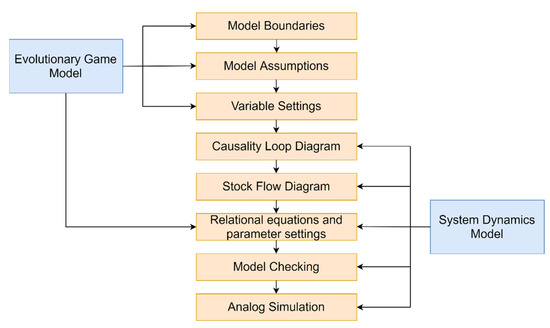
Figure 2.
Evolutionary game and SD modeling steps.
Next, this study uses Vensim PLE to develop an SD model of a three-party evolutionary game that includes three subsystems: government, ESCO, and owner. As shown in Figure 3, the tripartite evolutionary game’s SD model consists of three horizontal variables, three rate variables, six intermediate variables, and fourteen exogenous variables. Expressly: Three horizontal variables represent the probability of “GR”, the probability of “QS”, and the probability of “AR”. The three rate variables represent the rate of change in “GR”, the rate of change in the “QS”, and the rate of change in “AR”. The external variables then correspond to the parameters in the payoff matrix. The direction of the blue arrows represents the direction of causal action, with the initiating variable of the arrows being the cause and the receiving variable of the arrows being the effect. Furthermore, in the SD model of the evolution game, the flow equation and the functional relations among the level, rate, middle, and exogenous variables are analyzed through the evolutionary game.
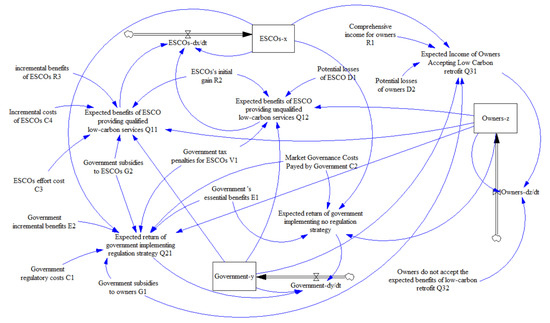
Figure 3.
SD model of tripartite evolutionary game.
4.2. Model Checking
In this paper, the LRRB tripartite evolutionary game model and the SD model are constructed, and the model’s validity needs to be verified for the accuracy of the subsequent analysis. The initial strategy of the triad of the easily known game is pure strategy 1 or 0. There are eight strategy combinations, and the evolutionary strategy under the pure strategy is always kept constant. In order to study whether the model remains stable when a pure strategy changes slightly, the probability of 0 is set to 0.01, and 1 is set to 0.99 in Vensim PLE to explore whether a slight change in the initial strategy of the three parties has an impact on the stability of the final evolution. The probabilities of ESCOs choosing “QS” are HQSx = 0.99 and LQSx = 0.01. The probability of the government choosing “GR” is HGRy = 0.99 and LGRy = 0.01. The owners chose “AR” for HARz = 0.99 and LARz = 0.01. There are eight initial strategies in the evolutionary game: (a) LQS-LGR-LAR; (b) LQS-LGR-HAR; (c) LQS-HGR-HAR; (d) LQS-HGR-HAR; (e) HQS-HGR-HAR; (f) HQS-LGR-HAR; (g) HQS-LGR-LAR; (h) HQS-HGR-LAR. On this basis, the three stages of the whole life cycle of the industry described above are simulated separately, and the following is a specific analysis of Stage 2—The development stage.
The parameters are set randomly: = 2, = 10, = 1, = 1; = 1; = 1, = 1, = 1, so that the parameters satisfy the inequalities . From Figure 4, it can be seen that no matter how the initial strategy changes, the tripartite strategy eventually evolves in the direction of (QS, GR, AR), i.e., reaching the evolutionary equilibrium point . The change of the initial strategy probability does not change the final strategy choice of the game subject, and this simulation result is consistent with the theoretical derivation, so the model is valid.
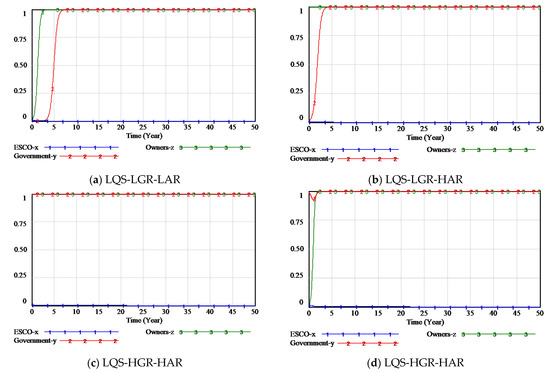
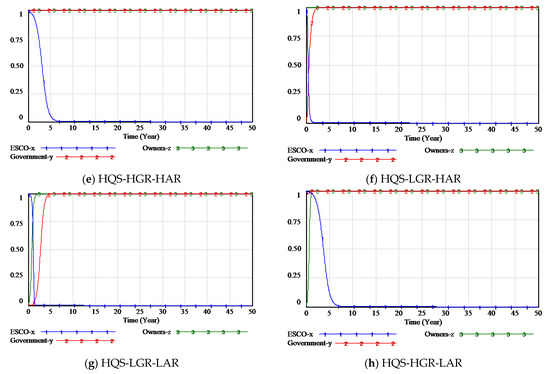
Figure 4.
Model checking results.
4.3. Case Overview
The building case is a 6-story unit house in the renovation project of Caochang Lane, a demonstration project of LRRB in Urumqi, Xinjiang, in cooperation with China and Germany. The building has a construction area of 4371.15 m2 and a service life of 25 years. The project adopts a guaranteed energy efficiency operation model, which means that after the project is completed, the owner will pay a one-time service fee to the ESCO if the ESCO achieves the energy efficiency promised in the contract. If the ESCO fails to achieve the energy efficiency promised in the contract, the difference in cost will be borne by the ESCOs.
4.4. Model Simulation
The initial variables of the evolutionary game model are determined based on the project profile, feasibility study report, and other relevant information and combined with relevant laws and regulations. This paper makes certain assumptions and estimates for the difficult-to-quantify parameters. The details are shown in Table 8. The settings of the SD model are shown in Figure 5, set INITIAL TIME = 0, FINAL TIME = 50, TIME STEP: 0.03125, Units for Time: Year, Integration Type: Euler, and initial values of exogenous variables according to Table 8. After setting, click “check model” to check the model, and when “model is OK” is displayed, the SD model based on the evolutionary game is built.

Table 8.
Parameter Variable Initial Values.
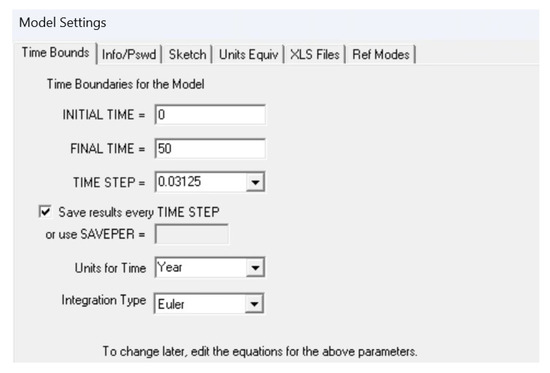
Figure 5.
Parameter setting.
The assignment of the parameter variables in Table 8 meets the requirement of . Since the initial values of x, y, and z do not influence the final choices of the participants in the evolutionary game but only the rate at which the equilibrium is reached, the initial probabilities of x, y, and z are set to 0.5. Then, the simulation of the behavioral strategies of the game subjects using the constructed SD model yields as the equilibrium point of the evolutionary game, and the simulation results are shown in Figure 6.
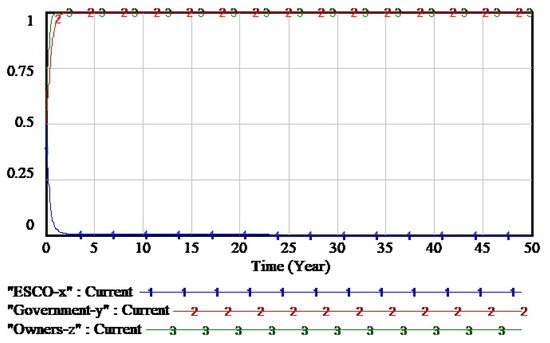
Figure 6.
Initial strategy diagram.
4.5. Model Simulation the Impact of Government Incentives
The government incentives can be divided into three types: 1. The government subsidizes only the ESCOs and does not subsidize the owners;. 2. The government subsidizes only the owners and does not subsidize the ESCOs. 3. The government subsidizes both the ESCOs and the owners. The three scenarios are discussed and analyzed below.
- 1.
- The government subsidizes only the ESCOs and does not subsidize the owners.
Based on the above case, real-time simulation is performed using Vensim PLE. The simulation results are shown in Figure 7. When = 0, = 3.5, 7.5, 10.5, and 16.5, respectively, and other parameters and initial strategies are kept constant. The simulation results show that when the government only subsidizes ESCOs, the probability of ESCOs choosing to “QS” increases as the government subsidy rises, but not the more the subsidy, the better the effect. When the subsidy exceeds a certain threshold, the probability curve of ESCOs choosing to “QS” oscillates, indicating that the incentive effect of the government on ESCOs starts to decrease. For the government, an increase in subsidy means an increase in the cost of inputs. When the subsidy exceeds the threshold value, the government’s behavior strategy changes from “GR” to “NGR”. The increase of government subsidies to ESCOs does not change the behavioral strategy of owners, and the probability of owners accepting LRRB fluctuates little.
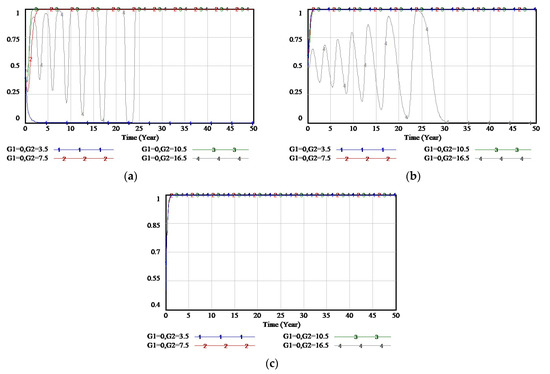
Figure 7.
The government subsidizes only the ESCOs. (a) ESCOs evolution strategy diagram; (b) Government evolution strategy diagram; (c) Owners’ evolution strategy diagram.
- 2.
- The government subsidizes only the owners and does not subsidize the ESCOs.
Let = 0 and = 2.5, 3.5, 4.5, and 5.5, respectively. Other parameters and the initial strategy remain unchanged. The obtained simulation results are shown in Figure 8. The simulation results show that when the government only subsidizes the owners, the owners will reach evolutionary stability more quickly as the subsidy increases. When the subsidy exceeds a certain threshold, the cost to the government is greater than the benefit. The government’s behavior strategy changes from “GR” to “NGR” when the government only subsidizes the owners; the ESCOs will still choose “NQS”. Therefore, government subsidies to owners only cannot achieve the purpose and effect of LRRB.
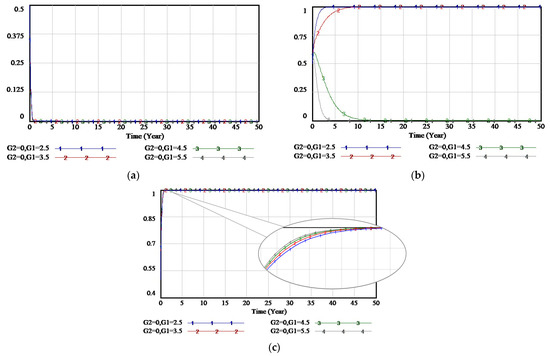
Figure 8.
The government subsidizes only the owners. (a) ESCOs evolution strategy diagram; (b) Government evolution strategy diagram; (c) Owners’ evolution strategy diagram.
Two scenarios are compared and discussed, namely, subsidies for ESCOs only and subsidies for owners only. Let = 0, = 7.5 (a1); = 0, = 7.5 (b1), respectively; the simulation results are shown in Figure 9. Under the same subsidy level, the incentive efficiency of government subsidy only for ESCOs is higher than for owners. Therefore, it is more reasonable to prioritize subsidizing ESCOs when the government subsidy funds are limited.
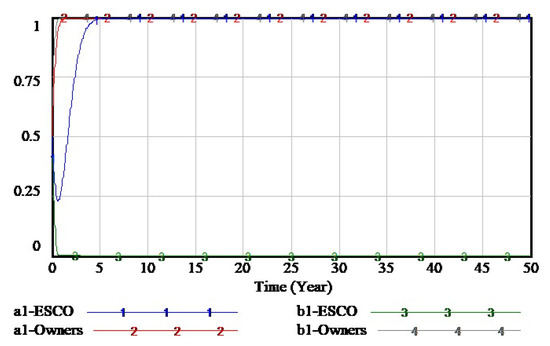
Figure 9.
Comparative analysis (subsidies for ESCOs only and subsidies for owners only).
To explore the effect of penalties on ESCO behavior strategy, let , , , and the simulation results are shown in Figure 10. increases so that the ESCO evolves from “NQS” to “NQS”. Then the initial value () is changed so that the condition satisfies Stage 2, i.e., the game subject’s strategy choice is (QS, GR, AR). In this stage, the impact of “subsidy without penalty” () and “subsidy+penalty” () on the behavior strategy of ESCOs is investigated, and the simulation results are shown in Figure 11. Under the condition of “subsidy + penalty”, ESCOs can reach the equilibrium of the stabilization point faster, and the government can make ESCOs perform qualified low-carbon retrofit services at a lower subsidy cost.
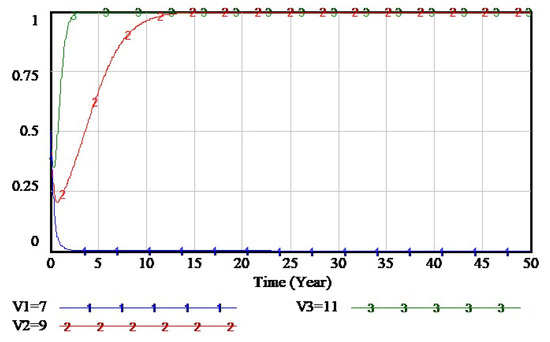
Figure 10.
Effect of fines on ESCOs behavior strategies.
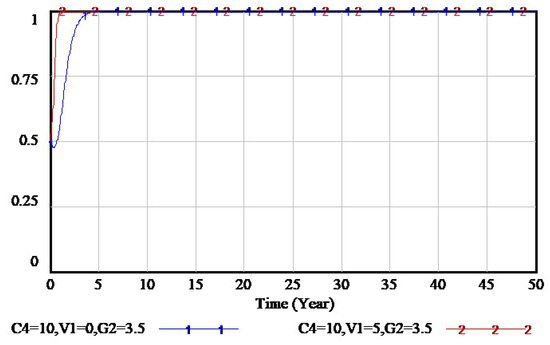
Figure 11.
Effect of the presence or absence of punishment on ESCOs’ behavioral strategies.
- 3.
- The government subsidizes both the ESCOs and the owners.
Through the real-time simulation of Vensim PLE, it can be found that when the benefit of the owner choosing to “AR” is greater than that of not accepting it, whether the government subsidizes the owners or not, the owners will decide to “AR”. In other words, government subsidies to owners do not play a substantial role. Whether owners accept LRRB depends on two factors: the owners’ overall benefits and the owners’ loss of energy savings due to the purchase of unqualified low-carbon services.
In this paper, real-time simulations are performed for the other main parameters. Using the variable control method, only the parameter variable to be studied is changed so that its value increases sequentially from 0. The effect of parameters on the behavior strategies of ESCOs, government, and owners is observed, and real-time simulation shows that the strategy chosen by the game players depends mainly on the cost and benefit, which reveals the nature of the game of three subjects is based on interests.
5. Suggestions
According to the results of the above study, this study will present some recommendations and measures from different stages of LRRB market development.
- (1)
- In the initial stage, as the invisible hand of the market, the government plays a vital role in driving the development of the LRRB market. ESCOs have high initial investment costs due to immature technology and materials. The cost is a crucial factor affecting the development of the LRRB market [39], which primarily hinders ESCOs from supporting LRRB. At this stage, on the one hand, the government should give proper guidance to encourage ESCOs to take full advantage of incentives. On the other hand, the government should strengthen the publicity and education of energy saving and carbon reduction knowledge, enhance owners’ retrofitting awareness, and change bad energy consumption habits through community activities, school curriculum, and mass media [40]. For ESCOs to gain a foothold in the LRRB market, they need to work on low-carbon technology innovations that will reduce the incremental cost of LBBR. Specific practices include the following: ESCOs should strengthen their collaboration with academic and research institutions to support the development of low-carbon technologies. At the same time, the government should invest more funds into educational research institutes and encourage them to develop sustainable new building materials to reduce the incremental cost of LRRB to promote the LRRB market.
- (2)
- In the development stage, the LRRB market is gaining momentum, and owners and ESCOs choose to support LRRB. However, ESCOs may pursue excess returns and adopt speculative behaviors at this stage. Establishing a reasonable reward and punishment mechanism can improve this situation. For the LRRB market to develop healthily, there is not only legal regulation and industry standard restraining behavior but also a variety of government incentives and penalties that must be implemented carefully [41]. Section 4.5 does not show that the more remarkable the government subsidies, the better the incentive effect. When the subsidy exceeds a certain threshold, the incentive effect of the subsidy will be weakened. Of course, Wang et al. [42] confirm that rational participants choose unsupported behavior in case of high decision-making costs, with little benefit, even with penalties. Therefore, the government should determine reasonable parameters of subsidies and penalties according to the game model.Due to information asymmetry, owners need help in information search and trust in low-carbon services provided by ESCOs. At this point, the government needs to establish an information service platform and improve the market mechanism. The behavioral strategies of government, ESCOs, and owners influence each other, and their cooperation and information sharing are crucial to achieving a sustainable low-carbon retrofit market for buildings. Information asymmetry is the main reason owners do not carry out LRRB. Therefore, the government can build an information service platform where information about building retrofit, energy efficiency, and related policies are released, thus reducing the cost and difficulty of information access [41]. At the same time, the government should clarify the service content of ESCOs and expose ESCOs that adopt speculative behavior to enhance the trust of owners in ESCOs and establish an excellent mutual trust relationship between ESCOs and owners. In addition, not merely technological advances and sustainable building materials needs to be promoted in the building retrofit market, but also get more feedback from LRRB. The lack of accurate data is the most critical factor in the absence of stakeholder confidence in retrofit projects [43]. The government can improve this situation by establishing a database of building energy consumption and a building assessment and certification system, which will enhance the quality of retrofit projects and provide more references for stakeholders [44,45]. At the same time, the government should develop and implement pilot projects and further improve the low-carbon retrofit market based on the feedback and experience gained from the pilot projects to implement LRRB fully.
- (3)
- In the mature stage, the autonomous-led mechanism helps reduce the market’s overdependence on the government. It facilitates the efficient development of the LRRB market in the long run, thus reducing the burden on the government. At this stage, a “fourth party” can be introduced, such as industry associations, media monitoring, and third-party testing agencies, to raise the awareness of self-regulation and responsibility of enterprises and gradually form an autonomous mechanism.
6. Conclusions
6.1. Conclusions
Studying stakeholders’ decision-making behavior in LRRB is crucial to promoting the market for buildings’ retrofit and improving urban sustainability development. Previous studies directly selected the three parties in the evolutionary game in LRRB without screening the stakeholders [46,47]. Some scholars ignore the critical role of the core stakeholder, the government, in guiding market development [48,49]. In addition, some scholars have conducted only theoretical analysis in this area, lacking empirical cases [50,51]. Based on this, the following work was conducted in this study: Firstly, this paper uses Mitchell’s score-based approach to identify the core stakeholders of LRRB among many stakeholders as ESCOs, government, and owners. Secondly, this research constructs a tripartite evolutionary game model of three subjects and tests its stable equilibrium point. Then, based on the actual cases, the effects of initial strategies and different parameters on the behavior of stakeholders are analyzed. Finally, based on the results obtained from the simulation, suggestions are promoted to encourage stakeholders to actively participate in energy efficiency retrofit.
Compared with previous similar studies, the results of this study provide new findings in three main areas:
- (1)
- First, Under the same level of subsidy, the incentive efficiency of government subsidy to ESCOs is higher than that of owners. So, when the government’s financial capacity is limited, it is more reasonable to prioritize subsidizing ESCOs.
- (2)
- Second, ESCOs can reach evolutionary equilibrium faster in the presence of penalties. From the government’s point of view, the government can spend less incentive cost to make ESCOs tend to “QS”. Hence, a “subsidy + penalty” measure is more effective than a “subsidy without penalty” measure.
- (3)
- Third, When the benefits of LRRB outweigh the losses, the owners will eventually reach the strategic equilibrium point of “AR”, regardless of whether the government subsidizes it. In this case, the government’s subsidies to owners do not play a substantial role.
6.2. Limitations and Future Research
This research still has the following limitations and room for further research: when using Vensim PLE simulation, certain assumptions are made on the initial setting parameters, which is an ideal model, and there are some complex practicalities to consider, such as owners’ income levels and the distribution of benefits between ESCOs and owners. The evolutionary model in this research is restricted to three subjects, simplifies the stakeholder relationships, and has yet to analyze other stakeholders in the LRRB. The participation of four or more stakeholders may have different results. In addition, the representative population size of the LRRB market deserves further discussion. Therefore, more in-depth research is needed for more elements in the subsequent study.
Author Contributions
Conceptualization, Z.Z. and W.W.; methodology, Z.Z.; software, J.S. and Z.Z.; validation, J.S., W.W.; formal analysis, W.W.; investigation, J.S. and Z.Z.; resources, W.W.; data curation, J.S.; writing—original draft preparation, Z.Z.; writing—review and editing, Z.Z.; visualization, J.S. and Z.Z.; supervision, W.W.; project administration, W.W. All authors have read and agreed to the published version of the manuscript.
Funding
This work was supported by the 2019 Science and Technology demonstration Project of the Ministry of Housing and Urban-Rural Development of the People’s Republic of China: “Technology Innovation and Model Summary for Transformation of Older Districts in Typical Regional Towns”. (Funding number: 2019-S-005).
Institutional Review Board Statement
Not applicable.
Informed Consent Statement
Not applicable.
Data Availability Statement
Not applicable.
Conflicts of Interest
The authors declare no conflict of interest.
Nomenclature
| GR | Regulation strategy |
| NGR | Non-regulation strategy |
| QS | Provide qualified low-carbon services strategy |
| NQS | Providing unqualified low-carbon services strategy |
| AR | Accepting LRRB strategy |
| NAR | Not accepting LRRB strategy |
| HGR | High probability of regulation |
| LGR | Low probability of regulation |
| HQS | High probability of providing qualified low-carbon services |
| LQS | Low probability of providing qualified low-carbon services |
| HAR | High probability of accepting LRRB |
| LAR | Low probability of accepting LRRB |
References
- Yang, S.; Yang, D.; Shi, W.; Deng, C.; Chen, C.; Feng, S. Global evaluation of carbon neutrality and peak carbon dioxide emissions: Current challenges and future outlook. In Environmental Science and Pollution Research; Springer: Berlin/Heidelberg, Germany, 2022. [Google Scholar] [CrossRef]
- He, L.; Chen, L. The incentive effects of different government subsidy policies on green buildings. Renew. Sustain. Energy Rev. 2021, 135, 110123. [Google Scholar] [CrossRef]
- CAOBEE. China Building Energy Consumption Annual Report 2020. J. Build. Energy Effic. 2021, 49, 1–6. [Google Scholar]
- Ren, S.; Li, X.; Yuan, B.; Li, D.; Chen, X. The effects of three types of environmental regulation on eco-efficiency: A cross-region analysis in China. J. Clean. Prod. 2018, 173, 245–255. [Google Scholar] [CrossRef]
- Yuan, M.; Li, Z.; Li, X.; Li, L.; Zhang, S.; Luo, X. How to promote the sustainable development of prefabricated residential buildings in China: A tripartite evolutionary game analysis. J. Clean. Prod. 2022, 349, 131423. [Google Scholar] [CrossRef]
- Khashe, S.; Heydarian, A.; Becerik-Gerber, B.; Wood, W. Exploring the effectiveness of social messages on promoting energy conservation behavior in buildings. Build. Environ. 2016, 102, 83–94. [Google Scholar] [CrossRef]
- Liu, K.; Zhou, H.; Kou, Y.; Zhang, J.; Zhou, X.; Zhang, X.; Farouk, A.; Zhen, D. Simulation study on passive buildings’ demand incentive based on evolutionary game. J. Intell. Fuzzy Syst. 2019, 37, 3163–3174. [Google Scholar] [CrossRef]
- Wang, Y.; Xue, L.; Gou, W. Evolutionary game in the participation of social capital in construction waste recycling projects-A perspective from government’s reward-penalty mechanism. J. Arid. Land Resour. Environ. 2022, 36, 30–37. [Google Scholar]
- Dolšak, J.; Hrovatin, N.; Zorić, J. Factors impacting energy-efficient retrofits in the residential sector: The effectiveness of the Slovenian subsidy program. Energy Build. 2020, 229, 110501. [Google Scholar] [CrossRef]
- Feng, Q.; Chen, H.; Shi, X.; Wei, J. Stakeholder games in the evolution and development of green buildings in China: Government-led perspective. J. Clean. Prod. 2020, 275, 122895. [Google Scholar] [CrossRef]
- Ozarisoy, B. Energy effectiveness of passive cooling design strategies to reduce the impact of long-term heatwaves on occupants’ thermal comfort in Europe: Climate change and mitigation. J. Clean. Prod. 2022, 330, 129675. [Google Scholar] [CrossRef]
- Song, J.; Wang, W.; Ni, P.; Zheng, H.; Zhang, Z.; Zhou, Y. Framework on low-carbon retrofit of rural residential buildings in arid areas of northwest China: A case study of Turpan residential buildings. Build. Simul. 2022, 16, 279–297. [Google Scholar] [CrossRef]
- Yang, X.; Zhang, J.; Shen, G.Q.; Yan, Y. Incentives for green retrofits: An evolutionary game analysis on Public-Private-Partnership reconstruction of buildings. J. Clean. Prod. 2019, 232, 1076–1092. [Google Scholar] [CrossRef]
- Zhang, Y.; Yi, X.; Qiu, H.; Chen, J.; Mahomed, F.M. An Evolutionary Game Analysis of Contractor’s Green Construction Behavior with Government Supervision and WeMedia’s Influence. Math. Probl. Eng. 2022, 2022, 6722223. [Google Scholar] [CrossRef]
- Qiao, W.; Dong, P.; Ju, Y. Synergistic development of green building market under government guidance: A case study of Tianjin, China. J. Clean. Prod. 2022, 340, 130540. [Google Scholar] [CrossRef]
- Liu, Y.; Zuo, J.; Pan, M.; Ge, Q.; Chang, R.; Feng, X.; Fu, Y.; Dong, N. The incentive mechanism and decision-making behavior in the green building supply market: A tripartite evolutionary game analysis. Build. Environ. 2022, 214, 108903. [Google Scholar] [CrossRef]
- Qiao, W.; Guo, H.; Li, W.; Qin, G. Research on Cooperation Development Mechanism of Existing Building Energy Efficiency Renovation Market Based on Tripartite Evolutionary Game. Build. Sci. 2020, 36, 70–79. [Google Scholar]
- Huang, M.-Q.; Lin, R.-J. Evolutionary Game Analysis of Energy-Saving Renovations of Existing Rural Residential Buildings from the Perspective of Stakeholders. Sustainability 2022, 14, 5723. [Google Scholar] [CrossRef]
- Xu, N.; Li, Q.; Xu, Q. Stakeholders of Large-scale Affordable Housing Projects in Coastal Cities Based on Social Network Analysis. J. Coast. Res. 2020, 104, 617–621. [Google Scholar] [CrossRef]
- Liang, X.; Yu, T.; Guo, L. Understanding Stakeholders’ Influence on Project Success with a New SNA Method: A Case Study of the Green Retrofit in China. Sustainability 2017, 9, 1927. [Google Scholar] [CrossRef]
- Xue, J.; Shen, G.Q.; Yang, R.J.; Zafar, I.; Ekanayake, E.M.A.C. Dynamic Network Analysis of Stakeholder Conflicts in Megaprojects: Sixteen-Year Case of Hong Kong-Zhuhai-Macao Bridge. J. Constr. Eng. Manag. 2020, 146, 04020103. [Google Scholar] [CrossRef]
- Lu, C.; Liu, H.-C.; Tao, J.; Rong, K.; Hsieh, Y.-C. A key stakeholder-based financial subsidy stimulation for Chinese EV industrialization: A system dynamics simulation. Technol. Forecast. Soc. Chang. 2017, 118, 1–14. [Google Scholar] [CrossRef]
- Yin, S.; Li, B.; Xing, Z. The governance mechanism of the building material industry (BMI) in transformation to green BMI: The perspective of green building. Sci. Total Environ. 2019, 677, 19–33. [Google Scholar] [CrossRef] [PubMed]
- Yuan, M.; Li, Z.; Li, X.; Luo, X. Managing stakeholder-associated risks and their interactions in the life cycle of prefabricated building projects: A social network analysis approach. J. Clean. Prod. 2021, 323, 129102. [Google Scholar] [CrossRef]
- Liang, X.; Shen, G.Q.; Guo, L. Improving Management of Green Retrofits from a Stakeholder Perspective: A Case Study in China. Int. J. Environ. Res. Public Health 2015, 12, 13823–13842. [Google Scholar] [CrossRef] [PubMed]
- Shah Ali, A.; Rahmat, I.; Hassan, H. Involvement of key design participants in refurbishment design process. Facilities 2008, 26, 389–400. [Google Scholar] [CrossRef]
- Zavadskas, E.K.; Kaklauskas, A.; Gulbinas, A. Multiple criteria decision support web-based system for building refurbishment. J. Civ. Eng. Manag. 2004, 10, 77–85. [Google Scholar] [CrossRef]
- Liang, X.; Peng, Y.; Shen, G.Q. A game theory based analysis of decision making for green retrofit under different occupancy types. J. Clean. Prod. 2016, 137, 1300–1312. [Google Scholar] [CrossRef]
- Mitchell, R.K.; Agle, B.R.; Wood, D.J. Toward a Theory of Stakeholder Identification and Salience: Defining the Principle of Who and What Really Counts. Acad. Manag. Rev. 1997, 22, 853–886. [Google Scholar] [CrossRef]
- Clarkson, M. A stakeholder framework and evaluating for analyzing corporate social performance. Acad. Manag. Rev. 1995, 20, 92–117. [Google Scholar] [CrossRef]
- Meng, Q.; Liu, Y.; Li, Z.; Wu, C. Dynamic reward and penalty strategies of green building construction incentive: An evolutionary game theory-based analysis. Environ. Sci. Pollut. Res. 2021, 28, 44902–44915. [Google Scholar] [CrossRef]
- Li, X.; Li, L. Evolutionary Game Analysis of Green Building Development Dynamic System under Government Regulation: From the Perspective of the Contractor. Math. Probl. Eng. 2022, 2022, 1987229. [Google Scholar] [CrossRef]
- Bobrova, Y.; Papachristos, G.; Cooper, A. Process perspective on homeowner energy retrofits: A qualitative metasynthesis. Energy Policy 2022, 160, 112669. [Google Scholar] [CrossRef]
- Claudelin, A.; Uusitalo, V.; Pekkola, S.; Leino, M.; Konsti-Laakso, S. The Role of Consumers in the Transition toward Low-Carbon Living. Sustainability 2017, 9, 958. [Google Scholar] [CrossRef]
- Jia, C.; Zhang, R.; Wang, D.; Salvati, D. Evolutionary Game Analysis of BIM Adoption among Stakeholders in PPP Projects. Complexity 2021, 2021, 5553785. [Google Scholar] [CrossRef]
- Ritzberger, K.; Weibull, J.W. Evolutionary Selection in Normal Form Games. Econom. J. Econom. Soc. 1995, 63, 1371–1399. [Google Scholar] [CrossRef]
- Friedman, D. On economic applications of evolutionary game theory. J. Evol. Econ. 1998, 8, 15–43. [Google Scholar] [CrossRef]
- Lyapunov, A.M. The general problem of the stability of motion. Int. J. Control 1992, 55, 531–534. [Google Scholar] [CrossRef]
- Lu, W.; Du, L.; Tam, V.W.Y.; Yang, Z.; Lin, C.; Peng, C. Evolutionary game strategy of stakeholders under the sustainable and innovative business model: A case study of green building. J. Clean. Prod. 2022, 333, 130136. [Google Scholar] [CrossRef]
- Zou, P.X.W.; Xu, X.; Sanjayan, J.; Wang, J. A mixed methods design for building occupants’ energy behavior research. Energy Build. 2018, 166, 239–249. [Google Scholar] [CrossRef]
- Wu, W.; Li, M.; Lai, X.; Deng, L. Promotion mechanism of the green building in the perspective of supply-side reform. Sci. Technol. Prog. Policy 2016, 33, 124–128. [Google Scholar]
- Wang, X.; Zhang, L.; Xiaorong, D.U. Industry Technology Innovation Alliance Based on Cooperation by Using Evolutionary Game Theory. Sci. Technol. Manag. Res. 2017, 9, 118–124. (In Chinese) [Google Scholar]
- Krieske, M.; Hu, H.; Egnor, T. The scalability of the building retrofit market: A review study. In Proceedings of the 2014 IEEE Conference on Technologies for Sustainability (SusTech), Portland, OR, USA, 24–26 July 2014; IEEE: Piscataway, NJ, USA, 2014; pp. 184–191. [Google Scholar]
- Xin, L.; Yan, D.; Yujia, T.; Neng, Z.; Zhe, T. Research on the evaluation system for heat metering and existing residential building retrofits in northern regions of China for the 12th five-year period. Energy 2014, 77, 898–908. [Google Scholar] [CrossRef]
- Liang, X.; Yu, T.; Hong, J.; Shen, G.Q. Making incentive policies more effective: An agent-based model for energy-efficiency retrofit in China. Energy Policy 2019, 126, 177–189. [Google Scholar] [CrossRef]
- Wang, S.-Y.; Lee, K.-T.; Kim, J.-H. Green Retrofitting Simulation for Sustainable Commercial Buildings in China Using a Proposed Multi-Agent Evolutionary Game. Sustainability 2022, 14, 7671. [Google Scholar] [CrossRef]
- Li, X.; Wang, C.; Kassem, M.A.; Liu, Y.; Ali, K.N. Study on Green Building Promotion Incentive Strategy Based on Evolutionary Game between Government and Construction Unit. Sustainability 2022, 14, 10155. [Google Scholar] [CrossRef]
- Gabay, H.; Meir, I.A.; Schwartz, M.; Werzberger, E. Cost-benefit analysis of green buildings: An Israeli office buildings case study. Energy Build. 2014, 76, 558–564. [Google Scholar] [CrossRef]
- Wallhagen, M.; Glaumann, M.; Malmqvist, T. Basic building life cycle calculations to decrease contribution to climate change–Case study on an office building in Sweden. Build. Environ. 2011, 46, 1863–1871. [Google Scholar] [CrossRef]
- Lv, J.; Lin, M.; Zhou, W. Fluctuation in construction costs and its effect on contract renegotiation behavior in PPP wastewater treatment projects: An evolutionary game analysis. J. Clean. Prod. 2021, 314, 128025. [Google Scholar] [CrossRef]
- Cai, G.; Kock, N. An evolutionary game theoretic perspective on e-collaboration: The collaboration effort and media relativeness. Eur. J. Oper. Res. 2009, 194, 821–833. [Google Scholar] [CrossRef]
Disclaimer/Publisher’s Note: The statements, opinions and data contained in all publications are solely those of the individual author(s) and contributor(s) and not of MDPI and/or the editor(s). MDPI and/or the editor(s) disclaim responsibility for any injury to people or property resulting from any ideas, methods, instructions or products referred to in the content. |
© 2023 by the authors. Licensee MDPI, Basel, Switzerland. This article is an open access article distributed under the terms and conditions of the Creative Commons Attribution (CC BY) license (https://creativecommons.org/licenses/by/4.0/).